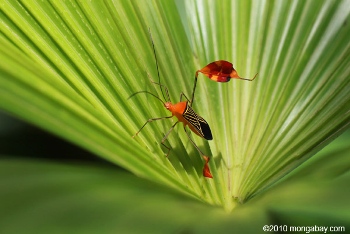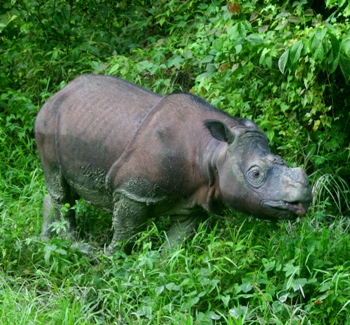One of the greatest barriers to saving the world’s biodiversity is simply a lack of knowledge: to date less than 50,000 species have been surveyed by the IUCN Red List regarding their threat level, while the vast majority of the world’s species are left unanalyzed especially fungi, plants, fish, reptiles, and insects and other invertebrates. To address this problem, some of the world’s top biologists have proposed a 60-million US dollar program they dub the ‘barometer of biodiversity’ to gather a representative sample of all taxons.
“Our knowledge about species and extinction rates remains very poor, and this has negative consequences for our environment and economy,” Simon Stuart, Chair of IUCN’s Species Survival Commission, said in a press release. “By expanding the current IUCN Red List of Threatened Species to include up to approximately 160,000 well-chosen species, we will have a good barometer for informing decisions globally.”
“The more we learn about indicator species, the more we know about the status of the living environment that sustains us all,” adds Edward O. Wilson, a world-renowned biologist and writer at the Museum of Comparative Zoology at Harvard University. “Threatened species, in particular, need to be targeted to enable better conservation and policy decisions.”
 The Anisocelis flavolineata, is an orange, black, yellow, and red flag footed bug. Like the vast majority of insects, it has not been evaluated by the IUCN Red List. To date only 7,615 invertebrates have been evaluated by the IUCN Red List out of 1,359,365 described species: 0.5 percent of the total. Photo by: Rhett A. Butler. |
Tripling the current number of species analyzed by the IUCN Red List would provide researchers with a “solid basis for informing decisions globally,” the authors write in the journal Science, “for example, on conservation planning, resource allocation, environmental impact assessments, monitoring biodiversity trends, and enabling countries to develop national-level biodiversity indicators,”
They estimate the entire expansion of the IUCN Red List would cost 60 million US dollars. Currently, much of the work done for the IUCN Red List is performed by volunteers. They propose analyzing an additional 35,000 vertebrates, 38,000 invertebrates, 25,000 plants, and 14,500 fungi and other species.
“The Red List is biased toward higher vertebrates. The vast majority of species—including most plants, invertebrates, and lower vertebrates, and almost all fungi—are still grossly underrepresented. A more finely tuned barometer is within reach by expanding the taxonomic base of the Red List to make it much more representative of the diversity of life,” the authors write. To date only 18 species of fungi have been analyzed by the IUCN Red List.
 This captive Sumatran Rhino is classified as Critically Endangered by the IUCN Red List: less than 250 individuals survive. The IUCN Red List has evaluated most mammals, birds, and amphibians. Photo by: Jeremy Hance. |
“We urgently need to ramp up current efforts to catalogue a far more representative selection of our vast biodiversity, while we still can, and we should focus first and foremost on those areas of highest extinction risk,” says Russell Mittermeier, President of Conservation International and Chair of IUCN/SSC Primate Specialist Group. “Such information will also help governments and communities to design appropriate responses to climate change and to other pressing conservation challenges.”
After centuries of taxonomic work, scientists have described 1.9 million species. However, this number is far below current estimates of the number of species living on Earth: researchers say it is likely that 10 to 20 million species inhabit the planet. If bacteria are added into this estimate, its likely it jumps another 10 million species or so.
“Knowledge about species and extinction rates remains very poor, and species disappear before we know they existed. […] It is time to accelerate taxonomy and scientific natural history, two of the most vital but neglected disciplines of biology,” the authors write.
Related articles
The Asian Animal Crisis
(03/18/2010) The United Nation declared 2010 as the International Year of Biodiversity (IYB). One of the goals of the IYB is to celebrate the achievements of the Convention of Biological Diversity signed by 192 countries since 1992. But what have we accomplished since 1992? Did we put an end to biodiversity loss? The truth is that there is not much to celebrate at all. Asia is a perfect example where the animal crisis and the loss of biodiversity have worsened over decades. The first question that should come to mind is: how many species have vanished in Asia because of human activities? Records of recently extinct species in Asia show 71 species that have disappeared in the wild. Examples include the Yunnan lake newt (Cynops wolterstorffi) from China, the Bonin thrush (Zoothera terrestris) from Japan, or the redtailed black shark (Epalzeorhynchos bicolor) from Thailand.
(03/09/2010) Extinctions are currently outpacing the capacity for new species to evolve, according to Simon Stuart, chair of the Species Survival Commission for the International Union for the Conservation of Nature (IUCN).
Website seeking ‘most wanted’ photos and videos of vanishing species
(03/04/2010) Many of the world’s most endangered species have never been photographed or caught on film. The not-for-profit website ARKive is hoping to change that. ARKive provides a collection of some of the best photos and video clips of the world’s species.
Extinct animals are quickly forgotten: the baiji and shifting baselines
(02/23/2010) In 2006 a survey in China to locate the endangered Yangtze River dolphin, known as the baiji, found no evidence of its survival. Despondent, researchers declared that the baiji was likely extinct. Four years later and the large charismatic marine mammal is not only ‘likely extinct’, but in danger of being forgotten, according to a surprising new study ‘Rapidly Shifting Baselines in Yangtze Fishing Communities and Local Memory of Extinct Species’ in Conservation Biology. Lead author of the study, Dr. Samuel Turvey, was a member of the original expedition in 2006. He returned to the Yangtze in 2008 to interview locals about their knowledge of the baiji and other vanishing megafauna in the river, including the Chinese paddlefish, one of the world’s largest freshwater fish. In these interviews Turvey and his team found clear evidence of ‘shifting baselines’: where humans lose track of even large changes to their environment, such as the loss of a top predator like the baiji.
Humans push half of the world’s primates toward extinction, lemurs in particular trouble
(02/18/2010) Of the known 634 primate species in the world 48 percent are currently threatened with extinction, making mankind’s closes relatives one of the most endangered animal groups in the world. In order to bring awareness to the desperate state of primates, a new report by the International Union for the Conservation of Nature highlights twenty-five primates in the most need of rapid conservation action. Compiled by 85 experts the report, entitled Primates in Peril: The World’s 25 Most Endangered Primates, 2008–2010, includes six primates from Africa, eleven from Asia, three from Central and South America, and five from the island of Madagascar.
Head of UN urges ‘a wake-up call’ to save biodiversity
(02/14/2010) Speaking at the American Museum of Natural History in New York City, UN Secretary General Ban Ki-moon said that “business as usual is not an option” to protect the world’ s biodiversity. The failure of governments worldwide to meet their pledges to protect biodiversity by 2010 is “a wake up call” according to Ki-moon.
Half of Indonesia’s species remain unknown
(02/02/2010) Incorporating 17,000 tropical islands, Indonesia is one of the world’s richest areas of biodiversity. However, according to the Jakarta Post, over half of this biodiversity remains unrecorded with only 20 of the more than 400 regencies in the country recording species.


